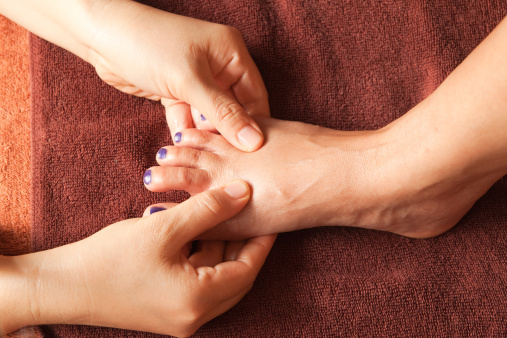How does reflexology work?
The art of reflexology is based on similar principles: energy meridians or ‘zones’ are accessed through the feet, and each foot can be mapped with all the internal organs, musculoskeletal system and glands in the body. Therefore, by pressing or rubbing a particular point in the foot, you can stimulate healing in the corresponding body part. Reflexology has its roots as far back as the Egyptians; illustrations were discovered in the tomb of Ankhmahor, also known as the Physicians Tomb, showing physicians working on the feet and hands of patients. More recently, in 1913, Dr William Fitzgerald, a nose, throat and ear specialist, noticed that some areas of the body, when stimulated, had an analgesic effect. He began to develop ‘zone theory’, which was later expanded upon by Euince Ingham and her nephew Dwight Byers, who she successfully treated for asthma using reflexology. Their research and practise in the 1960s became the reflexology we recognise today, with the familiar maps of the feet.
How do I find a reflexologist?
Choose an accredited therapist – governing bodies such as the Association of Reflexologists or the Federation of Holistic Therapists only have qualified therapists on their books. A qualified therapist won’t mind you asking where they trained and if they have insurance etc, so if you feel unsure, just ask. Unfortunately, it can be frustrating to go for a reflexology treatment for a specific condition, only to discover it’s more of a beauty treatment with a therapist who’s done a quick add-on style course (it does happen!). If you are after reflexology for pregnancy, or for a specific health problem, check with your therapist about it. Lots of reflexologists have an affinity with a particular area of health and have gone on to do further study. Ask friends and family for recommendations as word of mouth is always the best advertisement for a good practitioner.
What can you expect if you go for a treatment?
Reflexology is a holistic treatment, in that it treats the person as a ‘whole’, taking into consideration their physical, emotional, psychological and spiritual wellbeing. None of these aspects of a person exists in isolation, and the aim of reflexology is to bring more harmony or balance, enabling all parts of a person’s health to move towards equilibrium with one another. Your reflexologist will ask you questions about your general health, and further questions about your health history. They might ask questions about diet, exercise and lifestyle, not in a judgemental way, but to enable them to build up a thorough picture of you and your health at this moment in time. This means they can tailor the treatment to your needs.
You will either be treated lying on a couch, or seated in a reflexology chair with your feet up. Ideally the room will be calm, a comfortable temperature (your body temperature will drop after a while lying/sitting still, so it’s good to have a blanket if needed), and with lighting that is conducive to relaxation. Some therapists play relaxing music during treatment to help patients to switch off. You might be offered a foot bath beforehand, or your therapist will gently clean your feet when you are on the couch. A good treatment starts with ‘warming up the feet’, generally massaging and flexing the feet, rotating the ankles to gauge flexibility of the joints etc. This process also marks the beginning of the treatment, and offers you the chance to sink into relaxation. Some therapists encourage slow, deep breathing or use visualisation at this point. The treatment covers the whole of your feet and ankles, and sometimes up to the calves. Therapists use their thumbs or fingers to ‘caterpiller crawl’ over every area, applying pressure to particular points according to the picture they’ve built up of your needs during the consultation. They will likely ask you the kind of pressure you prefer beforehand and/or check in during the treatment. Though some areas can be highly sensitive, the overall feeling should be relaxing and not painful. The treatment usually ends with a relaxation massage or work on the energy meridians.
How will I feel afterwards?
Some people experience what is known as a ‘healing crisis’, which is actually a sign that the treatment has worked on a profound level. This is the body responding to treatment by eliminating toxins and working towards balance. Healing crisises can take different forms, but you might have a slight headache, nausea, dizziness, runny nose, or tearfulness, if your body is particularly congested. Your therapist will talk you through the possibility of healing crisis, and advise regularly sipping water to flush things through, and avoiding alcohol, caffeine and heavy meals. To get the most out of your treatment, it’s wise to schedule time to relax afterwards.
Many people don’t have a healing crisis, and can feel elated, uplifted, energised or deeply peaceful and healed afterwards. Sometimes, you can experience a buzz of energy – try and harness this as inner energy rather than expending it through activity, even if you do feel like cleaning the house top to bottom afterwards!
Your therapist will talk you through the best course of action for your particular needs. If you’re having reflexology for a condition, they will usually suggest weekly appointments until improvement is seen. For maintenance, wellbeing, and relaxation, people often favour a monthly reflexology appointment, or a seasonal one to help them adjust to external and internal changes.
Can I try it at home?
One of the really great things about reflexology is that you can achieve many of the benefits by practising on family and friends, and getting them to practise on you. Arm yourself with a good book on reflexology with clear maps of the feet and enjoy finding out more through practise. If you really want to see change in a particular area, it’s wise to find a reflexologist with knowledge who can advise and support you, however. They should be able to offer insights on ways to live holistically and intuitively to enable you to take an active role in your healing journey. I really like the way reflexology can help children and babies, and as it is such a gentle and non-invasive therapy, you can begin by massaging your child’s feet and then focusing on areas such as the digestive system for wind or colic, or the respiratory system for asthma etc. I find Barbara and Kevin Kunz’s book Reflexology for Children really useful and clear. They have written a range of books on reflexology and all of them have clear illustrations and a warm, friendly approach. Even holding and connecting with the feet can make the recipient feel loved and nurtured, so a simple foot massage is often all that’s needed.
World Reflexology Week
From 22-29 September, World Reflexology Week is an annual event highlighting the benefits of reflexology on a global scale. Now is the ideal time to find out more about this great treatment as the Week features events across the UK. Check with your local reflexologist or clinic to see if they’re running any special offers or taster days as your first step on a journey to good health!







